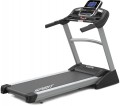Max. user weight
The highest weight of an athlete, at which the treadmill can work indefinitely for a long time (at least during the warranty period) without negative consequences. Most modern models have a "weight category" of the order of 150 kg and even more, which allows them to be used even by people of large build. However, there are exceptions, so this parameter is still worth paying attention to when choosing a treadmill.
It is worth choosing a model by weight with a significant margin — at least 10 kg more than your weight, even if you expect to lose it during training. If, on the contrary, you are going through a comprehensive training course to gain weight, then you should focus on the result you want by the end of the course. Anyway, the "weight category" of the machine must be greater than the weight of the user. Otherwise, the device will work with off-design loads and may break at any time.
If the treadmill is planned to be used for several users, you need to focus on the weight of the heaviest of them.
Motor power
Power of the motor installed in the electric treadmill (see "Load system"). This parameter is directly related, first of all, to the smoothness of the belt movement and the maximum speed (see above) — the more powerful the motor, the more uniform the movement of the belt will be and the faster it can move. Also, motor power determines the resistance to high loads: with an equal weight category (see "User weight"),
a more powerful model is better suited for people with large body weight, especially at high speeds.
In general, most recreational treadmills have motors between 1.5 and 2.5 hp; more powerful options usually belong to the professional class.
It is worth noting that above we were talking about the constant power of the motor — that is, the power with which it can work for a long time without being subjected to overloads. In some models of treadmills, the so-called peak power — the power that the motor can develop for a short time, for a few seconds. It is higher, but long-term operation at such a load is fraught with the failure of the device. Therefore, before buying, it is worthwhile to clarify, if possible, what power is implied in the specs — nominal or peak; this is especially true for high-power models.
Training programs
The number of
training programs provided for in the design of the simulator. This is not about load levels, but about automatic modes of operation, during which the belt can change the speed of movement, signal the beginning and end of a workout, etc. For details on the number of programs, see Programs and information.
Dimensions
The dimensions of the treadmill in the assembled state. It is important to note that more space is needed for the comfortable and proper operation of the treadmill.
Weight
The total weight of the treadmill when assembled.
All such treadmills are quite massive — models weighing up to 50 kg are considered
light. And when choosing, it is worth considering that both small and significant weight have their advantages. So, lightweight designs are more convenient when moving, while weighty ones are more stable, often have more extensive functionality, and are also better suited for people with large body weight.

